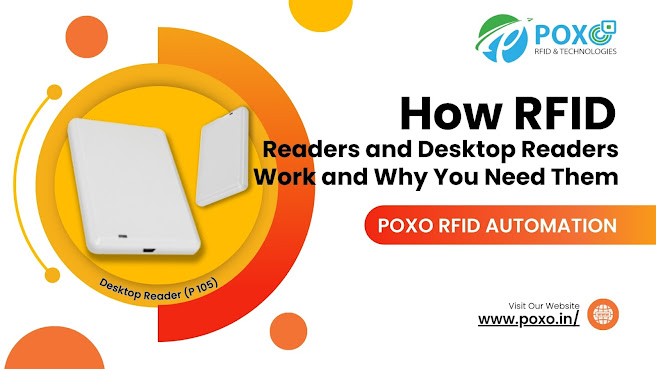How RFID Readers and Desktop Readers Work and Why You Need Them - POXO
In today's world, technology is advancing quickly. One exciting tool that's making a big impact is Radio-Frequency Identification (RFID) technology. It's changing the way we keep track of things. At the heart of this technology are RFID readers, and among them, desktop readers are really important.
Understanding
RFID Technology:
1. Basics
of RFID:
RFID readers are
devices that communicate with RFID tags to capture data stored within them.
These tags contain a unique identifier that can be read by the reader using
radio waves. The reader emits radio frequency signals, which power the tag and
enable it to transmit its information back to the reader.
2. RFID
Tags:
RFID tags are small devices equipped with a unique
identifier and an antenna. They come in various forms, such as passive (powered
by the reader's signal) or active (with an on-board power source). These tags
store information that can be read by an RFID reader.
3. RFID
Readers:
RFID
readers are devices that send out radio-frequency signals to activate
and read data from RFID tags. They play a pivotal role in collecting
information from tags and transmitting it to a central system for processing
and analysis.
Types of
RFID Readers:
1.
Handheld Readers:
These handheld devices are designed to be carried around,
allowing users to easily scan and collect data from RFID tags wherever they go.
Whether it's managing inventory on the shop floor or keeping tabs on assets in
a warehouse, handheld readers provide flexibility and convenience, making data
collection a breeze with just a simple point and scan.
2. Fixed
(Desktop) Readers:
Fixed or Desktop readers are stationary devices typically
connected to a computer or a network. They provide a convenient way to read
RFID tags without the need for manual scanning. With desktop readers,
businesses can streamline their inventory management processes by quickly
capturing tag data from items on shelves or in storage areas.
How Desktop
Readers Work:
1.
Antenna and Signal Transmission:
Desktop RFID readers consist of an antenna that emits
radio-frequency signals. When an RFID tag enters the reader's range, the
signals activate the tag, allowing it to transmit data back to the reader.
2. Data
Processing:
The reader processes the information received from the tag,
decoding the unique identifier and any additional data stored on the tag. This
data is then sent to a connected system for further processing.
3.
Connectivity:
Desktop readers are designed for easy integration with other
systems. They often connect to computers or networks, allowing seamless data
transfer for real-time monitoring and analysis.
Why You Need
RFID Readers:
1.
Efficiency and Accuracy:
RFID readers automate data collection processes, reducing
the need for manual entry. This improves efficiency and minimizes errors
associated with traditional tracking methods.
2.
Real-time Tracking:
Desktop
readers enable real-time tracking of items or individuals, providing
instant updates on their location and status. This is crucial for applications
like supply chain management and logistics.
3.
Enhanced Security:
In access control systems, desktop RFID readers
enhance security by allowing or restricting entry based on RFID tag authentication.
This ensures only authorized individuals have access to specific areas.
4.
Inventory Management:
For businesses, Desktop
RFID readers streamline inventory management by offering accurate and
up-to-date information on stock levels. This reduces the likelihood of
stockouts or overstock situations.
Conclusion:
In conclusion, RFID
readers, especially desktop readers, are indispensable in today's
data-driven world. Their ability to efficiently collect and process information
has transformed various industries, offering benefits such as increased
efficiency, real-time tracking, enhanced security, and improved inventory
management. As technology continues to evolve, the role of RFID readers in
shaping our interconnected world is only set to expand further.




Comments
Post a Comment